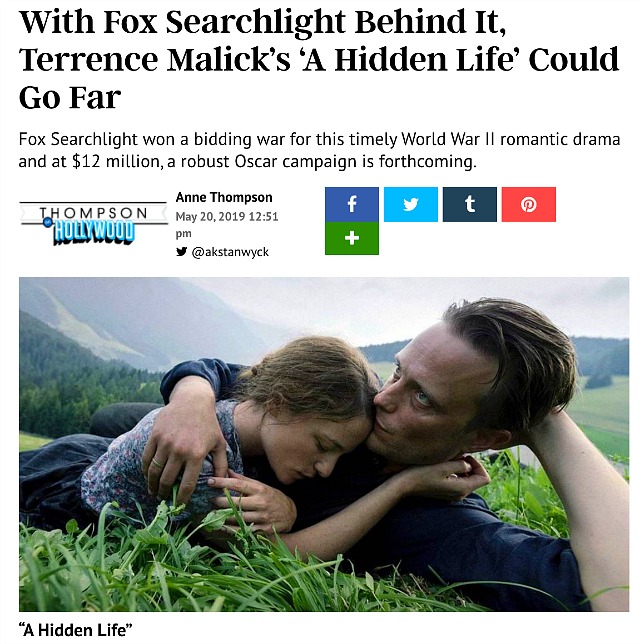It looks as if Terrence Malick‘s A Hidden Life (Fox Searchlight, 12.13) is dead, dead, dead all over. I’m sorry that it doesn’t appear likely to hang on a bit longer, but I’m not surprised. Malick has been burning his once–loyal (or at the very least intrigued) audience for years. And yet attention ought to be paid. For the eye-bath cinematography if nothing else. A little award-season action would help, but nothing’s happening. Tough deal, cold cards.


From “Malick’s ‘Hidden Life’ — Same Old Wackadoodle,” posted from Cannes on 5.19.19:
“The idea, then, was that A Hidden Life might represent a return to a kind of filmmaking that Malick hadn’t really embraced since these two films (respectively 14 and 20 years old), or perhaps even since Days of Heaven, which was shot 43 years ago and released in the fall of ’78.
“Because over the last decade (and I wish this were not so) Malick has made and released four story-less, mapped-out but improvised dandelion-fuzz movies — The Tree of Life (’10), To The Wonder (’12), Knight of Cups (’15) and Song to Song (’17).
“The fact that The Tree of Life was widely regarded as the first and best of Malick’s dandelion fuzzies (the principal traits being a meditative, interior-dreamscape current plus whispered narration, no “dialogue” to speak of and Emmanuel Lubezski cinematography that captures the wondrous natural beauty of God’s kingdom)…the fact that The Tree of Life was the finest of these doesn’t change what it basically is.
“So does A Hidden Life represent a return to the old days? Does it deliver an actual story with, like, a beginning, middle and end? Does it offer a semblance of character construction and narrative tension with some kind of skillfully assembled climax, etc.?
“No, it doesn’t. For Malick has gone back to the same old dandelion well with a generous lathering of Austrian countryside visuals plus some World War II period trimmings.
“Malick’s script tells Jagerstatter’s story but obliquely, as you might expect. The big dramatic turns are ‘there’, sort of, but are dramatically muted or side-stepped for the most part. I hate to repeat myself but A Hidden Life generally embodies a meditative, interior-dreamscape approach plus whispered narration, some “dialogue” but most of it spoken softly or muttered plus a lot of non-verbal conveyances, and some truly wonderful eye-bath cinematography by Jörg Widmer that more than lives up to Lubezski standards.
“The thing you get over and over from the film is how magnificent the locations look — mainly the small Italian mountain village of Sappada plus Brixen and South Tyrol, also in northern Italy.
“Otherwise it’s basically a moody, meditative swoon flick about a highly moral, independent-minded Austrian who couldn’t find a way to fight for the German army in good conscience, and who stuck to his guns and paid the price for that.”
